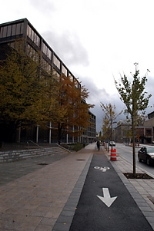The first phase of the Vassar streetscape project, one of the most dramatic areas of recent change on the MIT campus, is nearing completion. The overhaul of the street from Massachusetts Avenue to Main Street included new bicycle paths and spacious sidewalks, trees and streetlights, in addition to repaving.
A timetable for the second phase of the project, which will tackle the segment from Massachusetts Avenue to Audrey Street, has not been finalized.
Using information from studies of traffic patterns, the rebuilt section of Vassar Street has new systems to create a harmonious flow of drivers, cyclists and pedestrians. "The street functions the same way it did previously, except that we've changed the emphasis from cars to the pedestrian and cyclist," said Talitha Fabricius, landscape architect and senior project manager in the Department of Facilities. "We've widened the sidewalks, improved the crosswalks and given bicycles their own dedicated path separate from the road. The goal is to encourage people to walk and ride their bikes."
The Vassar streetscape project is part of an Institute initiative to unify the physical and aesthetic connections among MIT's buildings and public spaces. Paving materials and "street furniture" have a distinctive MIT style and character.
"We wanted to acknowledge the place of Vassar Street within the urban context, but at the same time celebrate the new buildings and the importance of the street with materials that are fresh and contemporary and that let you know that you are still on the MIT campus," Fabricius said.
While cyclists have their own lane on the street, pedestrians have crosswalks where the road is narrowed to shorten the distance they have to cross. To improve visibility, the number of light fixtures has been doubled, and small solar-powered lights are embedded in the pavement at the borders of the cycle track to highlight the approaches to driveways and intersections at night.
Three new blue light emergency telephones have been installed at the corner of Vassar Street and Massachusetts Avenue, near the entrance to Building 39, and at the stairs to Building 34. More phones will join the one at Building 44 as the frontage to the Stata Center nears completion.
Ginkgo trees, which tolerate urban conditions well, have been planted along the reconstructed stretch of the street.
A team of consultants led by the landscape architectural firm of Carol R. Johnson Associates, along with members of the MIT and Cambridge communities, developed the street redesign. Four major building projects on Vassar Street--the Stata Center, the brain and cognitive sciences project, the Zesiger Sports and Fitness Center, and Simmons Hall--have recently opened or will open within the next two years, potentially making Vassar Street one of the most lively areas of campus.
A version of this article appeared in MIT Tech Talk on November 5, 2003.






